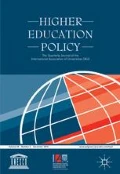Abstract
Responding to the impacts of globalization and the knowledge economy, the increasing demand for higher education in East Asia is not only met by domestic higher education, but also by importing transnational higher education (TNHE). Importing TNHE becomes an export strategy to attract international students to contribute to capacity building for the importing countries. While trading on the strength of west-dominated TNHE in East Asia is well received, its underlying dilemmas are under-represented. The paper aims to offer an alternative analysis to identify possible hurtful aspects that might be treated as ‘the Trojan Horse’ hidden in the import–export model that might aggravate rather than minimize student mobility and brain drain and deepen rather than alleviate the influence of western culture on East Asian countries. Hence, the overwhelming discourse of capacity building in importing TNHE should be critically re-visited by paying attention to foreign providers’ motives, the nature and characteristics of TNHE programmes, and the reality of the partnership process and arrangement.


Similar content being viewed by others
References
Altbach, P.G. (1998) Comparative Higher Education: Knowledge, the University and Development, Hong Kong: Comparative Education Research Centre, University of Hong Kong.
Bashir, S. (2007) Trends in International Trade in Higher Education: Implications and Options for Developing Countries, Washington DC: The World Bank.
Bennell, P. and Pearce, T. (2003) ‘The internationalization of higher education: Exporting education to developing and transitional economies’, International Journal of Educational Development 23 (2): 215–232.
Byun, K. and Kim, M. (2010) ‘Shifting patterns of the government’s policies for the internationalization of Korean higher education’, Journal of Studies in International Education 15 (5): 467–486.
Chapman, D., Cummings, W.K. and Postiglione, G.A. (eds.) (2010) Crossing Borders in East Asian Higher Education, Hong Kong: Hong Kong University Press.
Davis, D., Olsen, A. and Bohm, A. (eds.) (2000) Transnational Education Providers, Partners and Policy: Challenges for Australian Institutions Offshore, Canberra: IDP Education Australia.
Elkin, G., Devjee, F. and Farnsworth, J. (2005) ‘Visualizing the ‘internationalization’ of universities’, The International Journal of Educational Management 19 (4): 318–329.
Ennew, C. (2011) ‘Strategic Mobility Diversification’, in OBHE (ed.) Borderless 2011: Perspectives on the Future, London: The Observatory on Borderless Higher Education, p. 14.
Feng, G. and Gong, S. (2006) Sino-Foreign Joint Education Ventures: A National, Regional and Institutional Analysis, London: The Observatory on Borderless Higher Education.
Garrett, R. (2003a) Higher Education in China, Part 1: Context and Regulation of Foreign Activity, London: The Observatory on Borderless Higher Education.
Garrett, R. (2003b) Higher Education in China, Part 2: Scale of Foreign Activity and Examples, London: The Observatory on Borderless Higher Education.
Garrett, R. and Verbik, L. (2003) Transnational Higher Education, Part 2: Shifting Markets & Emerging Trends, London: The Observatory on Borderless Higher Education.
Helms, R.M. (2008) Transnational Education in China: Key Challenges, Critical Issues, and Strategies for Success, London: The Observatory on Borderless Higher Education.
Huang, F. (2010) ‘TNHE in Japan and China: A Comparative Study’, in D. Chapman, W.K. Cummings and G.A. Postiglione (eds.) Crossing Borders in East Asian Higher Education, Hong Kong: Hong Kong University Press, pp. 265–282.
Knight, J. (2005) Borderless, Offshore, Transnational and Cross-Border Education: Definition and Data Dilemmas, London: The Observatory on Borderless Higher Education.
Knight, J. (2011) ‘Education hubs: A fad, a brand, an innovation?’ Journal of Studies in International Education 15 (3): 221–240.
Kuroda, K. and Passarelli, D. (2009) Modelling TNE Directions in Asia, London: The Observatory on Borderless Higher Education.
Lee, M.H. (2005) ‘Cross-border higher education in the Republic of Korea: From challenge to opportunity’, Paper presented at UNESCO Forum on Implication of WTO/GATS on Higher Education in Asia & the Pacific, 27–29 April, Seoul, Republic of Korea.
McBurnie, G. and Ziguras, C. (2009) ‘Trends and Future Scenarios in Programme and Institution Mobility Across Borders’, in OECD (ed.) Higher Education to 2030 (Volume 2: Globalization), Paris: OECD, pp. 84–108.
Mok, K.H. (2007) ‘Questing for internationalization of universities in Asia: critical reflections’, Journal of Studies in International Education 11 (3–4): 433–454.
Mok, K.H. (2008) ‘Singapore’s global education hub ambitions: University governance change and transnational higher education’, International Journal of Educational Management 22 (6): 527–546.
Morshidi, S., Razak, A.A. and Koo, Y.L. (2011) ‘Trade in services and its policy implications: The case of cross-border/transnational higher education in Malaysia’, Journal of Studies in International Education 15 (3): 241–260.
Olds, K. (2007) ‘Global assemblage: Singapore, foreign universities, and the construction of a global education hub’, World Development 35 (6): 959–975.
Seah, W.T. and Edwards, J. (2006) ‘Flying in, flying out: Offshore teaching in higher education’, Australian Journal of Education 50 (3): 297–311.
Shams, F. and Huisman, J. (2011) ‘Managing offshore branch campuses: An analytical framework for institutional strategies’, Journal of Studies in International Education 19 August, doi: 10.1177/1028315311413470.
UNESCO and Council of Europe. (2001) Code of Good Practice in the Provision of Transnational Education, Bucharest: UNESCO-CEPES.
Verbik, L. and Merkley, C. (2006) The International Branch Campus-Models and Trends, London: The Observatory on Borderless Higher Education.
Vincent-Lancrin, S. (2005) Building Capacity through Cross-border Tertiary Education, London: The Observatory on Borderless Higher Education.
Vincent-Lancrin, S. (2009) ‘Cross-Border Higher Education: Trends and Perspectives’, in OECD (ed.) Higher Education to 2030 (Volume 2: Globalization), Paris: OECD, pp. 63–88.
Yonezawa, A. (2007) ‘Strategies for the emerging global higher education market in East Asia: Comparative study of Singapore, Malaysia and Japan’, Globalization, Societies and Education 5 (1): 125–136.
Ziguras, C. (2003) ‘The impact of the GATS on transnational tertiary education: Comparing experiences of New Zealand, Australia, Singapore and Malaysia’, Australian Educational Researcher 30 (3): 89–110.
Author information
Authors and Affiliations
Rights and permissions
About this article
Cite this article
Chiang, Lc. Trading on the West’s Strength: The Dilemmas of Transnational Higher Education in East Asia. High Educ Policy 25, 171–189 (2012). https://doi.org/10.1057/hep.2012.7
Published:
Issue Date:
DOI: https://doi.org/10.1057/hep.2012.7




